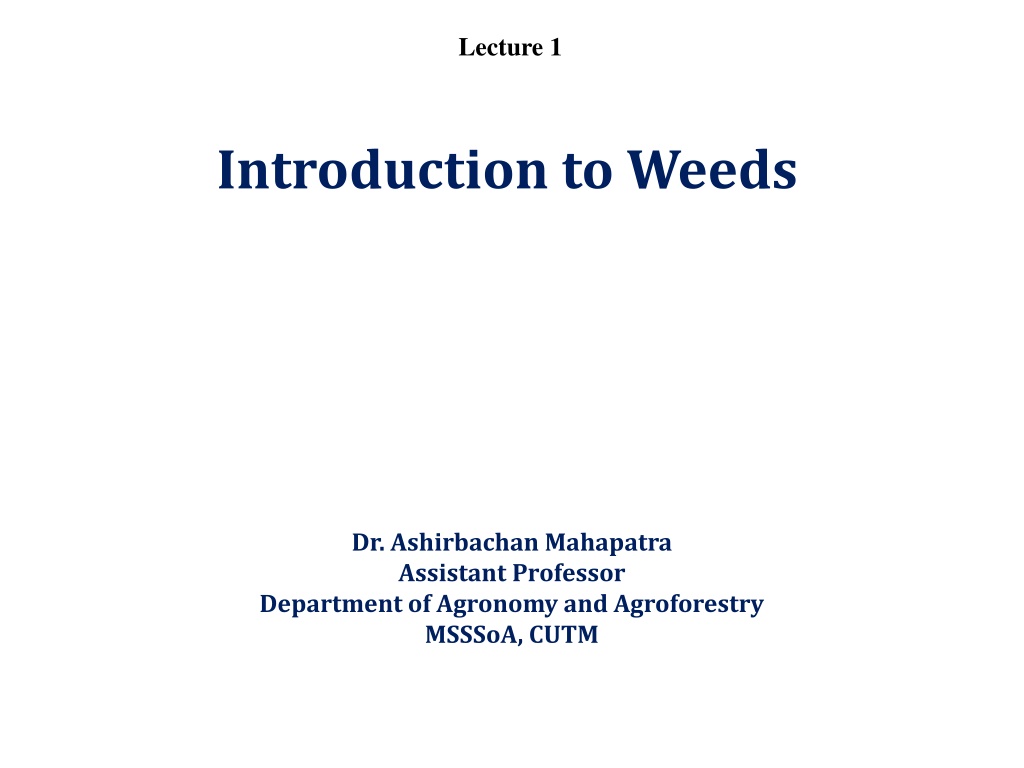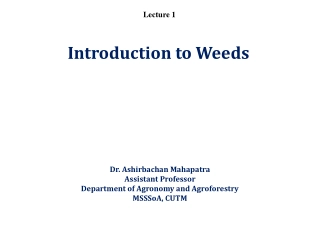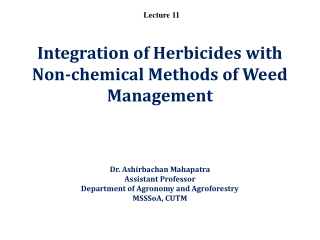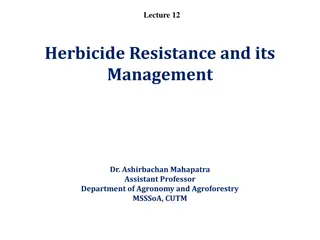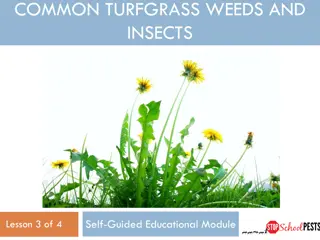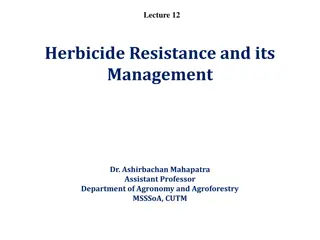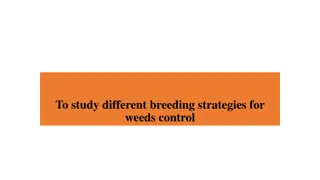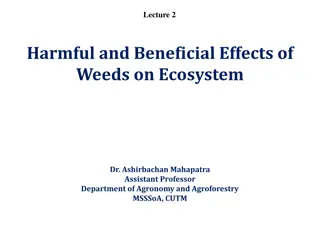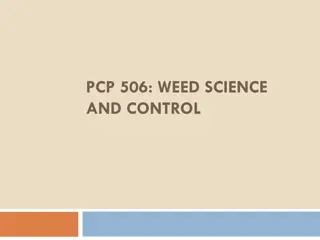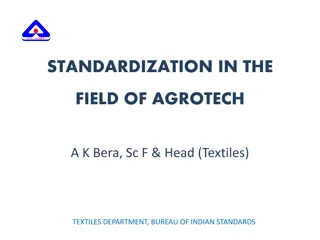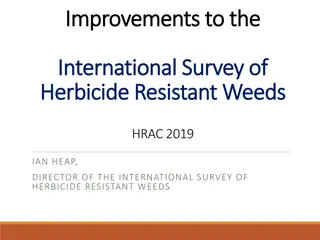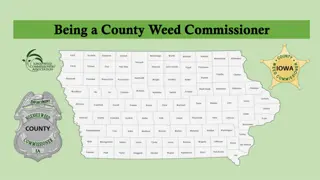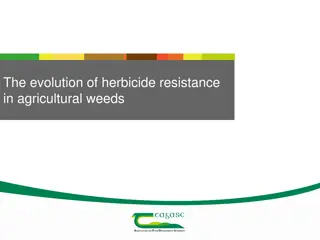Understanding Weeds: Origins, Impact, and Definitions
Weeds have been a persistent challenge in agriculture since ancient times, with origins stemming from both man's conscious efforts and natural plant invasions. This lecture delves into the impact of weeds on crop production and presents various definitions of weeds as plants growing where they are not desired. The content discusses the significant economic losses caused by weeds globally and highlights the defining characteristics that distinguish weeds from desired vegetation.
Download Presentation

Please find below an Image/Link to download the presentation.
The content on the website is provided AS IS for your information and personal use only. It may not be sold, licensed, or shared on other websites without obtaining consent from the author. Download presentation by click this link. If you encounter any issues during the download, it is possible that the publisher has removed the file from their server.
E N D
Presentation Transcript
Lecture 1 Introduction to Weeds Dr. Ashirbachan Mahapatra Assistant Professor Department of Agronomy and Agroforestry MSSSoA, CUTM
Origin of Weeds Weeds are no strangers to man. They have been there ever since farmer started to cultivate crops about 10,000 BC and undoubtedly recognized as a problem from the beginning. Any plant in the field other than his crop became weed. Again the characters of certain weed species are very similar to that of wild plants in the region. Some of the crops for example including the wheat of today are the derivatives of wild grass. Man has further improved them to suit his own taste and fancy. Even today they are crossed with wild varieties to transfer the desirable characters such as drought and disease resistance. So the weeds are to begin with essential components of native and naturalized flora but in course of time these plants are well placed in new environment by the conscious and unconscious efforts of man.
Hence, it is considered that many weeds principally originated from two important and major arbitrarily defined groups. 1. By man s conscious effort 2. By invasion of plants into man created habits In the world there are 30,000 weed species, out of these 18,000 sps cause damage to the crops. Jethro Tull first coined the term weed in 1731 in the book Horse Hoeing Husbandry Weeds are competitive and adaptable to all the adverse environments. It has been estimated that in general weeds cause 5% loss to Agricultural production in most developed countries. 10% loss in less developed countries and 25% loss in least developed countries.
Definition of Weed Weeds are the plants, which grow where they are not wanted (Jethro Tull, 1731). In 1967, the Weed Science Society of America defined a weed as a plant growing where it is not desired (Buchholtz, 1967). In 1989 the Society s definition was changed to define a weed as any plant that is objectionable or interferes with the activities or welfare of man (Humburg, 1989, p. 267; Vencill, 2002, p. 462). The European Weed Research Society defined a weed as any plant or vegetation, excluding fungi, interfering with the objectives or requirements of people (EWRS, 1986) The Oxford English Dictionary (Little et al., 1973) defines a weed as a herbaceous plant not valued for use or beauty, growing wild and rank, and regarded as cumbering the ground or hindering the growth of superior vegetation. A plant out of place or growing where it is not wanted W.S. Blatchley 1912 A plant that is growing where it is desired that something else shall grow A.E. Georgia 1916 The obnoxious plants are known as weeds W.W. Robbins et al. 1942
Those plants with harmful or objectionable habits or characteristics which grow where they are not wanted, usually in places where it is desired that something else should grow. A plant growing where we do not want it E.J. Salisbury 1961 A plant growing where it is not desired; or a plant out of place G.C. Klingman 1961 Aldrich (1984) and Aldrich and Kremer (1997, p. 8) offered a definition that does not deny the validity of others but introduces a desirable ecological base. A weed is a plant that originated in a natural environment and, in response to imposed or natural environments, evolved, and continues to do so, as an interfering associate with our crops and activities. This definition provides both an origin and continuing change perspective (Aldrich, 1984). Aldrich wants us to recognize weeds as part of a dynamic, not static, ecosystem. His definition departs from those that regard weeds as enemies to be controlled.
Characteristics Features of Weeds To develop appropriate weed control, the characteristic features of weeds have to be known. 1. Prolific seed production One of the most pernicious habits of weeds is their vigorous reproduction. In general, annual weeds are characterized by the production of very large number of seeds. Seed production varies from 40 to 1,96,000 no. of seeds/plant. Sl. No. Weed Species Av. No. of seeds/plant 1 Amaranthus spp. 1,96,000 2 Cuscuta spp. 16,000 3 Chenopodium album 72,000 4 Cynodon dactylon 170 5 Cyperus rotundus 40 6 Commelina benghalensis 2450 7 Portulaca sp. 1,93,000 8 Trianthema sp. 52,000 9 Solanum nigrum 1,78,000 10 Eleusine indica 41,200
2. Vegetative reproduction The vegetative reproduction is another way by which the weeds were able to spread. Some of the perennial weeds multiplied by various means like tubers and nuts (nut grass), rhizomes and root stock (Bermuda grass & Johnson grass), bulbs (wild onion and garlic), roots (Canada thistle), stems (dodder) and offsets (aquatic weeds). 3. Seed dormancy Dormancy is a state of seeds and buds in which they are alive but not germinated. If all weed seeds were to germinate at one time, their seedlings could be destroyed. Dormancy allows storage of millions of weed seeds in soil and enables them to grow in flushes over years. In this context, the old gardeners saying One year seeding seven years weeding is very appropriate. In fact, weed seeds have been found viable even after 20-80 years of burial in soil. Weed seeds exhibit three types of dormancy: 1. Enforced dormancy 2. Innate dormancy 3. Induced dormancy
(1) Enforced Dormancy: It is due to deep placement of weed seeds in soil during ploughing of the field. Weed seeds germinate readily when they are restored to top 3 to 5 cm. Enforced Dormancy is a non-specific character of seed. Cultivation encounters enforced dormancy by bringing the weeds to surface where they are exposed to light besides better aeration. High soil temperature and NO3 content of surface soil may further help in breaking seed dormancy. (2) Innate dormancy: It is a genetically controlled character and it is a feature of specific weed seeds which fail to germinate even if they are present in the top 3-5 cm soil and adequate soil moisture and temperature provided to them. The possible reasons are the presence of: (i) Hard seed coats e.g., Setaria, Ipomoea, Xanthium spp. (ii) Immature embryos e.g., Polygonum In certain weed seeds particularly of Xerophytic origin, presence of inhibitors is responsible for innate dormancy. It can be overcome with passage of time, or under the influence of some climatic pressure. (3) Induced Dormancy: Induced dormancy results from some sudden physiological change in normally non-dormant weed seeds under the impact of marked rise in temperature and or CO2 content of soil, low O2 pressure, water logging etc. Wild oat (Avena fatua) seeds exhibit all three kinds of dormancy.
4. Longevity and viability of seeds Lotus seed collected from the bottom of the Manchurian lake bed have viability even after 1000 years. Where as wild mustard and Chenopodium remain viable for 30 and 20 years, respectively. 5. Weed seed dispersal and germination Weed dispersal has no geographical boundaries. Common agents of weed dispersal are wind, water, animals, birds, organic manures, agriculture implements and human beings. 6. Wider adaptability They have ability to thrive under adverse conditions due to morphological and physiological conditions Eg. Trianthema (carpet weed), Sorghum halepens and Saccharum spontaneum 7. Modified structure in order to compete with crop plants They are provided with hooks, stiff hairs, thorns and spines Example: Argemone, Xanthium, Tribulus, and Achyranthus spp.
Other characteristic features are 8. Germination synchronization between weeds and crop plants. Flush of weeds germinates along with crop plants. 9. Rapid establishment and growth of weed seedlings. 10. Tolerance to shading effects by the crops at the time of establishment. 11. Quick response to available soil moisture and nutrients. 12. Relative immunity to post seeding soil disturbance practices. 13. Mimicry: Resembles the crop plants, morphological characters are similar to the crop Plants. Example: Wild oat in wheat crop and Echinochloa colonum in rice. 14. Resistance to herbicides in use thus weeds are called as excellent competitors.
